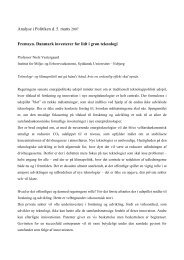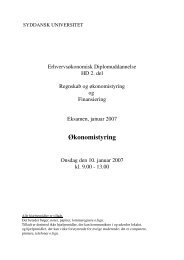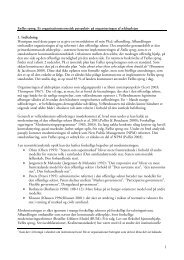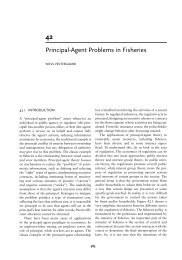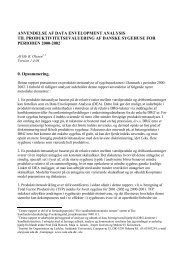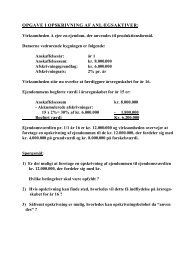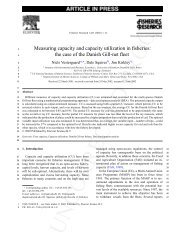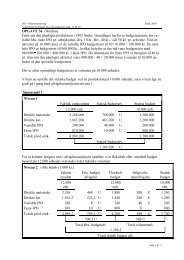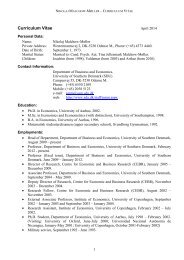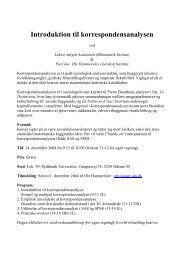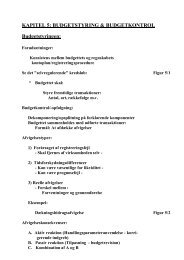elections <strong>and</strong> the Slovak communists who surpris<strong>in</strong>gly were represented <strong>in</strong> parlament at the 2002election.Political strategies were to a large extent determ<strong>in</strong>ed by aims <strong>of</strong> recognition <strong>and</strong> survival. As notedby John Ishiyama <strong>and</strong> András Bozóki the communist successor parties have passed their own<strong>in</strong>ternal transformations. The post-communist parties adopted various strategies <strong>of</strong> adaption to thepost-communist environment, <strong>and</strong> strategies were chang<strong>in</strong>g over time. Seen <strong>in</strong> that perspective,party change can be considered as a rational <strong>and</strong> purposeful moves by the partis <strong>in</strong>volved, <strong>in</strong>response to <strong>in</strong>ternal or external stimuli. Major changes have <strong>of</strong>ten been precipitated by poorelectoral performance.The take-over <strong>of</strong> governmental responsibilities came earlier than first expected. The participation <strong>in</strong>government made a deideologiz<strong>in</strong>g, pragmatiz<strong>in</strong>g impact. As noticed above, the limited freedom <strong>of</strong>maneuvre <strong>in</strong> the economic <strong>and</strong> social policy turned the political Left closer to the political middle,however, at the same time remov<strong>in</strong>g those parties away from the voters <strong>and</strong> the civil societies. Atthe national elections <strong>in</strong> 1996 <strong>and</strong> 1997 <strong>in</strong> Bulgaria, Romania, Lithuania <strong>and</strong> Pol<strong>and</strong> transformationloosers <strong>and</strong> socially marg<strong>in</strong>alised felt themselves deceived by the “postcommunists”. Many decidedto be “s<strong>of</strong>a-voters” or alternately vote on the right-traditionalist market sceptical populist parties.The electoral support for the neoliberals rema<strong>in</strong>ed modest, mostly encompass<strong>in</strong>g the “transitionw<strong>in</strong>ners”.Be<strong>in</strong>g <strong>in</strong> government the policy <strong>of</strong> the Left was determ<strong>in</strong>ed by the low freedom <strong>of</strong> maneuvre <strong>in</strong> theeconomic <strong>and</strong> social policy, marked by a specific postcommunist pathdependency. Opposite, afterthe fall <strong>of</strong> communism, the rul<strong>in</strong>g socialist parties <strong>in</strong> the South European countries had to movesocieties from plan to market under extremely difficult conditions <strong>in</strong>ternally as well as externally,thus without carry<strong>in</strong>g through the social dimension promised dur<strong>in</strong>g the election campaigns. Alsothe left governments had to pass the “valley <strong>of</strong> tears” before – slowly – mov<strong>in</strong>g to economicgrowth.Ishiyama <strong>and</strong> Bozóki identify four different adaption strategies among left-w<strong>in</strong>g post-communistparties: the national/populist, the orthodox communist, the modernization/reformist <strong>and</strong> the nationalcommunist. Ishiyama <strong>and</strong> Bozóki dist<strong>in</strong>guish between four different types <strong>of</strong> post-communiststrategies:• Leftist-retreat <strong>in</strong>volves the successor party embrac<strong>in</strong>g its Marxist traditions (reject<strong>in</strong>g thefree market), repudiat<strong>in</strong>g western <strong>in</strong>fluence, <strong>and</strong> adopt<strong>in</strong>g the status <strong>of</strong> an anti-systemopposition party. This pattern is a long way exemplified by PDS <strong>in</strong> Germany <strong>and</strong> KSCM <strong>in</strong>the Czech Republic.• The strategy <strong>of</strong> pragmatic reform attempts to distance itself from “dogmatic Marxism” <strong>and</strong>redef<strong>in</strong><strong>in</strong>g the party <strong>in</strong>volved as a “European” social democratic party consist<strong>in</strong>g <strong>of</strong>“experts”, “technocrats” <strong>and</strong> “pragmatists”.• The national-patriotic strategy, which unlike the pragmatic reform strategy does not <strong>in</strong>volvean attempt to redef<strong>in</strong>e the party as a “European” social democratic party. Rather this strategyseeks to associate the party with nationalism, a modern ideological alternative tocommunism. This strategy <strong>of</strong>ten <strong>in</strong>volves the formation <strong>of</strong> “red <strong>and</strong> brown” coalitions or so-26
called “nationalist-patriotic” <strong>and</strong> “fatherl<strong>and</strong>” fronts such as has been the case <strong>in</strong> e.g. Russia<strong>and</strong> Romania.1.9. Coalition build<strong>in</strong>gSeveral election party alliances have merged, <strong>of</strong>ten with the explicit aim to pass the tresholdrequirements stated <strong>in</strong> the lection laws, only rarely the explanation as an approximation on theelitelevel or the policy <strong>and</strong> programme level. As we shall se <strong>in</strong> the cases <strong>of</strong> Solidarity <strong>in</strong> Pol<strong>and</strong><strong>and</strong>the Quadre Coalition (4K) the obstacles for establish<strong>in</strong>g functional party federations became almost<strong>in</strong>surmountable. The ma<strong>in</strong> problem was to create the sufficient loyalty on actor level <strong>and</strong> thenecessary cohesion on the policy <strong>and</strong> programme level. A common “federal” party identity wasalmost impossible to establish. On macro level, the change <strong>of</strong> party identity can be expla<strong>in</strong>ed asmuch by factors <strong>in</strong>ternal to the parties <strong>in</strong>volved <strong>in</strong> the federation as by external factors, i.e. factorsfrom the outside 20 .In several cases only loosely <strong>in</strong>stitutionalized party-alliances <strong>and</strong> umbrella-parties wereestablished. As noticed above, <strong>in</strong> several cases we have been deal<strong>in</strong>g with negative party alliancesthat were focus<strong>in</strong>g on a common enemy such as SDK <strong>in</strong> Slovakia (Meciar), AWS <strong>in</strong> Pol<strong>and</strong> (”postcommunists”)<strong>and</strong> the Four Coalition (4K) <strong>in</strong> the Czech Republic (Klaus <strong>and</strong> Zeman). These partyalliances were not able to obta<strong>in</strong> sufficiently stable <strong>and</strong> def<strong>in</strong>itive party memberships, rather wehave been deal<strong>in</strong>g with ”participants <strong>in</strong> their actions” (Ágh, 1998:103). In general, the cohesion <strong>and</strong>loyalty on the elite level has been low. The movement parties tried to express the ”orig<strong>in</strong>al” <strong>and</strong>”ideal” unity <strong>of</strong> society <strong>and</strong> party. However, they were organizationally fragile, mostly transitorypolitical phenomena, never constitut<strong>in</strong>g functional political parties like we f<strong>in</strong>d them <strong>in</strong> “st<strong>and</strong>ard”competitive multi-party systems. The cult <strong>of</strong> spontaneity <strong>and</strong> the movement l<strong>in</strong>e may overcome thedivision between everyday life <strong>and</strong> politics considered <strong>in</strong> the broader sense, but only <strong>in</strong> the shortterm.Figure : types <strong>of</strong> cooperation <strong>and</strong> alliances among parties <strong>in</strong> the CEESTypes <strong>of</strong> cooperation/alliances Characteristics ExamplesTransitory governmentsNormally formed just after the demise<strong>of</strong> the old system <strong>and</strong> until the firstfree election, <strong>of</strong>ten set up accord<strong>in</strong>g toa compromise between representativesfrom the old <strong>and</strong> new system, i.e. theoppositionNegative party alliancesTactical alliancesCooperation between parties primarilybased on a common enemy, i.e. the(post)communists <strong>and</strong> <strong>in</strong> spite <strong>of</strong>disagreements on both policy <strong>and</strong>actor level<strong>Party</strong> cooperation with the primaryaim to secure the parties <strong>in</strong>volved aThe first non-communist government<strong>in</strong> Pol<strong>and</strong>, the government <strong>in</strong>Czechoslovakia after the velvetrevolution until the first free electionMay-June 1990Election Alliance AWS <strong>and</strong> the AWS-UW government <strong>in</strong> Pol<strong>and</strong>, the SDKledgovernment <strong>in</strong> Slovakia after the1998 election, Democratic Convention<strong>in</strong> Bulgaria, <strong>and</strong> (partly) the 4K <strong>in</strong> theCzech RepublicThe first stage <strong>of</strong> the four partycooperation (4K) <strong>in</strong> the Czech20 John Ishiyama <strong>and</strong> András Bozóki, “Adaption <strong>and</strong> Change:Characteriz<strong>in</strong>g the Survival Strategies <strong>of</strong> the CommunistSuccessor <strong>Parties</strong>, Journal <strong>of</strong> Communist Studies <strong>and</strong> Transition Politics, Vol.17, No.3, September 2001:32-51.27
- Page 3: “This provisional situation chara
- Page 6 and 7: marketisation and privatisationshor
- Page 8 and 9: purposes, are channels for “expre
- Page 10 and 11: the significance of strategic choic
- Page 12 and 13: presidentialism gave rise to “flo
- Page 14 and 15: antipolitics and reinforcement of a
- Page 16 and 17: In the late 1990’s elections most
- Page 18 and 19: determined primarily by “politica
- Page 20 and 21: politics and antipolitics, all sign
- Page 22 and 23: which attitudes to state regulation
- Page 24 and 25: Anti-communism has been defined in
- Page 28 and 29: Cartel agreementsbetter representat
- Page 30 and 31: Basically the absence of clear cons
- Page 32 and 33: After 1989 different types of polit
- Page 34 and 35: complex project for transition unde
- Page 36 and 37: window of opportunity in spite of s
- Page 38 and 39: analyses of party institutionalizat
- Page 40 and 41: political messages and slogans. Thu
- Page 42 and 43: well established party culture may
- Page 44 and 45: expected, much due to the many spli
- Page 46 and 47: Furthermore, the polarisation on el
- Page 48 and 49: Finally, Solidarity can also be con
- Page 50 and 51: whole, on the one side an authorita
- Page 52 and 53: The economic recession and the grav
- Page 54 and 55: election defeat more cooperation an
- Page 56 and 57: The formation of AWS can be conside
- Page 58 and 59: group. RS AWS constituted the Chris
- Page 60 and 61: According to the original plans the
- Page 62 and 63: values. According to Rybicki, as so
- Page 64 and 65: AWS should fight against all types
- Page 66 and 67: 2001 parliamentary election, howeve
- Page 68 and 69: and workers voted ZChN. At the 1993
- Page 70 and 71: The League has been considered as a
- Page 72 and 73: establishment like than LPR’s. Th
- Page 74 and 75: jobs in rural areas, especially sma
- Page 76 and 77:
industrial policy. According to the
- Page 78 and 79:
pressurizing the government to give
- Page 80 and 81:
democrats, thereby locating itself
- Page 82 and 83:
To conclude, the Freedom Union (UW)
- Page 84 and 85:
Polish middle class. Thus, in Janua
- Page 86 and 87:
such as KSCM and KSS in The Czech R
- Page 88 and 89:
The SLD leaders were mainly recruit
- Page 90 and 91:
the falling popular support for pri
- Page 92 and 93:
innovation was formation of the pol
- Page 94 and 95:
place after talks with each applica
- Page 96 and 97:
Has the Left any freedom of manoeuv
- Page 98 and 99:
medicine, changes in the labour cod
- Page 100 and 101:
The Labour Union (UP), Democratic U
- Page 102:
Nevertheless, before that had taken



